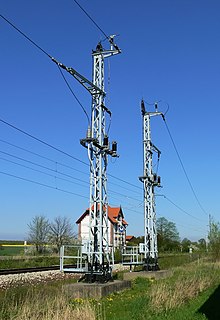Separation point (catenary of railway and trolleybus systems)
Separation points in the catenary of electric railways or trolleybuses serve to avoid short circuits between line sections, which must remain electrically isolated from one another for trouble-free operation even when an electric traction vehicle is passing through . Special designs and procedures must be observed here.
Infeed separation points for substations
In power supplies with single phase ac of 15 kV, 16.7 Hz at full tracks and with direct current for trams and underground trains (here busbars ) separation points for the edible portions of successive partially traction power - substations installed. The catenary has a short-energized at this point, in some special cases also grounded portion.
Phase separation point
A phase separation point is a transition between contact line sections that are fed by different phases of the three-phase grid. By distributing the three phases of the three-phase network over approximately 80 to 100 kilometers of route sections, the aim is to achieve a more even distribution of energy in the supply network. This applies to electrified lines that are operated with the usual 50 Hz or 60 Hz industrial power system.
System separation point
A separation point between two traction current systems with different frequencies , voltages or types of current is called a system separation point . Multi-system vehicles are necessary to drive through such routes . At these points the main switch has to be switched off and the vehicle switched over, in some cases it has to be ironed and often another pantograph has to be put on for the next section. This is necessary if the contact wire lateral deflection changes due to different clearance profiles , for example between Germany and Switzerland, or if different pallet materials are required. The latter is often the case between DC and AC voltage networks.
→ Main article: System separation point
Signaling
The points at which the main switch must be switched off or on again are indicated by square signal boards with three white bars in the shape of a U on a blue background , standing on their tips . The signals are mostly illuminated or reflective, there has also been an announcement signal since the 1990s.
- Turn off the main switch: The three bars are separated.
- Turn on the main switch: The three bars merge.
In many countries such as Germany, Austria, Spain and all of Southeast Europe, practically identical signals can be found in white on a blue background. In the Czech Republic and Slovakia, instead of white stripes, long, round reflectors were common.
In Switzerland, the signals are not at the top, the signal boards are black on a yellow background.
Separation point passage
When an electrically operated train passes through a separation point, the power supply must be briefly interrupted. Before entering a section of the separation point, the tractive force is first switched off and then the main switch of the traction vehicle is switched off, while the train continues to roll towards the separation point. This means that all power consumers are switched off and the train busbar is de -energized. The indispensable consumers are supplied by the vehicle batteries, the train rolls through the separation point due to the existing kinetic energy . After they have passed, i.e. as soon as the last lifted pantograph of the train has passed the switch-on signal, the main switch is switched on again, all consumers receive voltage and the driver can switch on again.
In many locomotives, the switching off and on of the main switch can be heard in the form of a clacking or hissing sound when driving through a separation point, especially in railcars near the pantograph.
Large and not absolutely necessary ancillary services such as air conditioning and sockets in the passenger compartments are not supported by the vehicle batteries; they are de-energized when driving through protective routes and system separation points. With the ICE-T and ICE 3, this also applies to the liquid crystal panes between the passenger compartment and driver's cab in the lounges , which become opaque for a few minutes.


